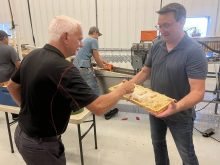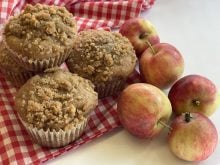For me, springtime is the busiest time of the year. All of a sudden winter is over and dandelions are blooming, the garden needs rototilling, grass needs fertilizing and cutting, perennials cleaned up, windows washed, and the list goes on.
Inside, the traditional spring cleaning is a thing of the past. It can wait until… sometime. Springtime is also a time of new beginnings. New puppies and baby chicks are at the farm, new leaves are on the trees and as always, new hopes for the little seeds being planted in the fields to grow big and bountiful.
Read Also

Vintage power on display at Saskatchewan tractor pull
At the Ag in Motion farm show held earlier this year near Langham, Sask., a vintage tractor pull event drew pretty significant crowds of show goers, who were mostly farmers.
Canning broth
Dear TEAM: I would like to know how to safely can liquid broth that I make myself from soup bones. I would like to be able to open a jar of broth to make soup with later. How long would it take to process a clear broth only, with no meat chunks or veggies in a canner? I usually only make chicken or beef broth. – Francis, e-mail.
Dear Francis: Whether it is a clear broth or a broth with meat and/or vegetables, to be safe it must be processed in a pressure canner rather than a hot water bath canner. The reason is that broths, vegetables and meats are low acid foods and botulism can survive in them. The high heat of a pressure canner is needed to destroy any botulism that might be present. In a hot water bath canner, the heat will never get high enough to destroy botulism, no matter how long you process it.
Another option would be to freeze the stock in containers the size you would like. Easy and safe.
In Bernardin Guide To Home Preserving, third edition, 2003, the following instructions are given for pressure canning stocks.
- Place the required number of clean mason jars on a rack in a pressure canner or large saucepan; add water and heat jars to a simmer (180 F/82 C). Set screw bands aside; heat snap lids in hot water, not boiling (180 F/82 C).
- Ladle hot stock into hot jars to within one inch (2.5 cm) of top rim. Using nonmetallic utensil, remove air bubbles.
- Wipe jar rims removing any stickiness. Centre lid on jar; apply screw band securely and firmly until resistance is met. Do not overtighten. Place jars in canner.
- Follow canner manufacturer’s instructions to adjust water level and heating instructions. Vent canner by allowing steam to escape steadily for 10 minutes. Close vent.
- When canner reaches the pressure appropriate for your altitude and type of pressure canner, begin counting processing time.
Pressure: At altitudes up to 1,000 feet (305 metres) use 10 pounds
(68 kPa) weighted gauge pressure. For 1,001 feet and higher, increase the pressure to 15 lb. (102 kPa).
Time: The processing time for low acid foods does not change with a change in altitude, just the amount of pressure.
Beef and chicken stock: 500 millilitre jars, 20 minutes; one litre jars, 25 minutes.
Vegetable stock: 500 mL jars, 30 minutes; 1 L jars, 35 minutes.
- When processing time is complete, turn off the heat. Allow canner to stand undisturbed until pressure drops to zero. Wait two minutes, and then carefully remove cover, tilting it away from your face. Remove jars without tilting. Cool upright, undisturbed for 24 hours. Do not retighten screw bands.
- After cooling, check jar seals. Store in a cool, dark place.
Food safety quiz
1. The best way to avoid food poisoning is to:
(a) Use bacterial soaps.
(b) Buy only organic food.
(c) Wash your hands with plain soap and water before and after handling food.
(d) Eat only at home, not at restaurants.
2. Cooked foods should be refrigerated within:
(a) 30 minutes.
(b) Two hours.
(c) Three hours.
(d) Four hours.
3. Which are potential sources of foodborne illness?
(a) Raw eggs, poultry, beef, seafood.
(b) Unwashed produce.
(c) Raw sprouts.
(d) Unpasteurized milk, apple juice and apple cider.
4. Which cutting board is safer?
(a) Plastic.
(b) Wooden.
5. If you get sick from eating an egg salad sandwich left out too long, the most likely culprit is the:
(a) Bread.
(b) Eggs.
(c) Mayonnaise.
(d) Relish.
6. True or false:
Hard cheese with some surface mould does not need to be tossed.
7. True or false:
Raw meats can be marinated at room temperature, because the marinade kills bacteria.
8. True or false:
It’s safe to refreeze thawed or partially thawed foods.
9. True or false:
Packaged salad greens labelled prewashed or triple washed don’t need further washing.
10. True or false:
The sniff test is a reliable way to tell if food is tainted with bacteria.
Answers
1. (c) Avoid food poisioning with frequent and thorough handwashing. Plain soap will do. Antibacterial products are not more effective and may contribute to drug-resistant bacteria. More people get food poisoning at home, though illness caused by restaurant meals is more likely to be reported.
2. (b) However, if the weather is hot, food should be refrigerated within one hour. Remember to count the time it takes you to eat.
3. (all) It’s not just animal foods that can harbour microbes. Besides cooking meat to proper temperature and eggs until not runny, wash all produce including organic, which is also susceptible to microbes, with plain water. People with weakened immune systems, as well as the old and young, should not eat raw sprouts, which have been linked to illness caused by E. coli and Salmonella bacteria.
4. Either a plastic or wood cutting board is fine, as long as you scrub it with soap and water after cutting raw meat, poultry or fish on it. One advantage of plastic is that you can put it in the dishwasher. You may want to have different boards for raw meats and produce. Replace boards that have deep grooves or cracks.
5. (b) Bacteria thrive on high-
protein foods such as eggs, tuna and chicken, not in store-bought mayo. Homemade mayonnaise made from raw eggs can cause salmonella
poisoning.
6. True. Just cut off at least an inch (2.5 cm) beyond the mouldy cheese. The same goes for hard fruits and vegetables, such as apples and potatoes. Soft fruits and cheeses with mould should be discarded.
7. False. Marinate all meat, poultry and seafood in the refrigerator. Do not add leftover marinade to the cooked meat unless you boil it first. Transfer the cooked meat to a clean platter, not back to the dish that held the raw meat.
8. True, as long as the food still has ice crystals or is below 40 F (4 C). Refreezing may, however, affect the food’s flavour and texture.
9. True. Greens and other vegetables washed at the processing plant and labelled as such are probably cleaner than home-washed greens can ever be, but you pay extra for the convenience. Greens that aren’t
labelled as having been washed should be thoroughly washed.
10. False. You usually can’t smell or taste the microbes that cause food poisoning. Still, if food does smell bad, throw it out.
Source: University of California, Berkeley Wellness Letter.
All occasion food
Here are two recipes from Timeless Recipes for All Occasions by Jean Paré, first introduced as Jean’s Millennium Edition souvenir cookbook in 1999. Each of the 250 past and present favourite recipes are pictured in full colour.
Baked onions
A nice onion flavour that is not overbearing because the rice is cooked with the onion.
2 tablespoons hard 30 mL
margarine
6 cups chopped onion 1.5 L
1/2 cup uncooked long 125 mL
grain white rice
1/4 teaspoon salt 1 mL
2/3 cup skim 150 mL
evaporated milk
1 cup grated muenster 250 mL
cheese
Melt margarine in non-stick frying pan. Add onion, rice and salt. You may need to do this in batches. Sauté until onion is soft. Turn into large bowl. Add evaporated milk and cheese. Stir well. Turn into greased 11/2 quart (1.5 L) casserole. Cover. Bake in 350 F (180 C) oven for 55 minutes. Remove cover. Bake for five minutes until browned. Makes about five cups (1.25 L).
Bubble and squeak
This is an old recipe from Britain. Cabbage adds to its appearance and texture.
4 cups mashed potatoes 1 L
4 cups cooked cabbage, 1 L chopped
1 teaspoon salt 5 mL
1/4 teaspoon pepper 1 mL
2 tablespoons hard 30 mL
margarine or butter
Mix first four ingredients in large bowl. Shape into patties. Melt margarine in non-stick frying pan. Brown patties on both sides. Makes eight large or 16 medium patties.
Variation: This may be browned in one big patty, then flipped to brown other side. It may also be scramble-fried instead of made into patties.
Alma Copeland is a home economist from Elrose, Sask., and one of four columnists comprising Team Resources. Send correspondence in care of this newspaper, Box 2500, Saskatoon, Sask., S7K 2C4 or contact them at team@producer.com.
















